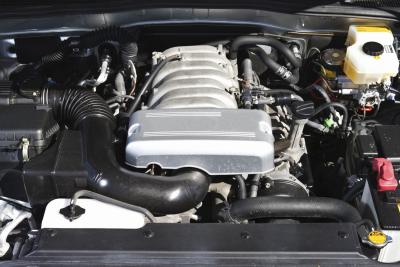
Valves define what it means to be a four-stroke engine. All engines require air and fuel for combustion inside their closed combustion chambers; after combustion, those used gases must depart to make room for more air and fuel. Intake and exhaust valves are the doors that permit air/fuel to enter and exhaust gases to leave the engine's combustion chambers.
Four-stroke engines are so-called because the piston moves up and down ("strokes") four times for each combustion cycle ("power stroke"). As the intake valve opens, the piston moves downward to suck in fresh air and fuel. The valve closes, and the piston moves up to compress the air/fuel mixture. The spark plug ignites the mixture, which pushes the piston downward with the force of its explosion. The exhaust valve opens, and the rising piston pushed the spent gases out of the chamber.
Intake and exhaust valves are known as "poppet" valves. Poppet valves have a round head that blocks a hole (the "port"); the "stem" attached to the back of this "valve head" pushes the valve up and away from the port, allowing air/fuel to flow through the gap between the valve head and valve seat and into the combustion chamber. Poppet valves work well in engines because the pressure inside the combustion chamber pushes the valve against the seat, sealing the chamber and preventing leaks.
Valves open and close with a set of springs and levers known as a "valvetrain." A spring holds the valve closed and is counteracted by a lever called a "rocker arm" to open the valve. The rocker arm is connected directly to the camshaft (a cylinder with raised lobes that push against the rocker arms) on overhead-cam engines. On "pushrod" (a.k.a. "cam-in-block") engines, the camshaft pushes against the rocker arms indirectly via the lifters (which ride on the camshaft lobes) and the pushrods (metal stems that connect the lifters and rocker arms).
The poppet valves used in four-stroke engines have three major drawbacks. The first and most severe is that air/fuel must flow around the valve head to get into the cylinder, which limits power and efficiency. The second is that the valves themselves are fairly heavy, but must open and close many times a second to keep up with the piston. If the valve's inertia overcomes the valvespring's ability to control it, the valve never completely closes and goes into what is known as "valve float." This not only limits high-RPM power, it can be disastrous if a floating valve happens to hit the piston.
To reduce weight and increase RPM potential, racing engine builders often use high-strength alloy valves made of chrome-molybdenum, beryllium alloy and Inconel steel. These super-strong alloys can allow the builder to make the valve stems thinner or even hollow to reduce mass. Some engines (like Subaru's EJ-series "boxer 4") use hollow, sodium-filled valves. The sodium melts during operation and acts as a coolant, which helps to prevent "hot-spotting" in the combustion chamber and the subsequent engine-destroying knock ("detonation").